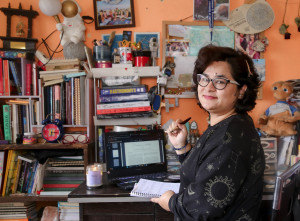Culture & Lifestyle
Dislocation and anxiety of belonging in biracial women
Hollay Ghadery's 'Fuse' is a searing account of her struggle to come to terms with her biracial identity and the resultant mental health issue.
Fathima M
It is tricky to define memoirs. It is one way to connect ourselves (often a conflicted self) to the world outside and discover ourselves again. Indeed, it is an individual's desire and effort to tell their story, but memoirs are more than just one's life story. It is akin to ekphrasis, albeit the painting here is one's own life, and memory interspersed with current circumstances plays an essential role in its making. However, it needs to be reiterated that memoirs are never merely personal accounts; the craftsmanship of memoirs deserves further delving into it as a serious art form. The unique tone and narrative technique are a means toward a broader context. Reading memoirs of writers from diverse backgrounds can be an informative and personally uplifting process.
Hollay Ghadery's memoir 'Fuse' is a searing account of her struggle to come to terms with her biracial identity and the resultant mental health issue. The challenges of being biracial and having mental health issues are barely discussed in academia or journalism, making Ghadery's work not just a personal revelation but also an essential scholarship on biracial complexities as experienced by women. She emphasises her gender because men and women deal differently with biracial experiences and mental health crises. The tendency to club all biracial experiences together is flawed and has limitations; hence the memoir genre is best suited for this kind of storytelling.
Born to a Canadian mother of British descent and an Iranian-Muslim father, Ghadery is expected to follow specific rules and maintain social propriety. As expected, Ghadery (or anyone for that matter) can't follow the norms of a society that is nothing but a fantasy for her since she is geographically and culturally distant from it—in her case, far away from Iran. These stringent expectations create an identity crisis, and Ghadery ends up having a "schizophrenic" existence. I first heard about this phrase in an interview with the Moroccan-French writer Leila Slimani, who described the dual roles she played in Morocco and France as schizophrenia. This can be extended in this context, where the intersection of eastern and western values creates more problems than is usually perceived. Ghadery grew up in Canada, and she was expected to act as an Iranian-Muslim woman or a Muslim woman. The author does not give a rosy picture of freedom in the West which is a relief for a reader in the East. While the West symbolises freedom for many people, it is surprising that Ghadery had to struggle to live in a different city away from home to attend college.
She is also candid about the lack of money and the odd jobs she took to become financially independent, all of this reminding one of the age-old and over-quoted work by Virginia Woolf. When women stop conforming to social etiquette, having "a room of one's own" becomes a worry. The patriarchal society is not particularly friendly towards single women who want the freedom to make choices. Being biracial, Ghadery was always expected to think and act from two distinct cultural perspectives, not belonging entirely to either. In one instance, she writes about how modesty is perceived in the West and the Middle East. Ghadery writes, "In Western culture, the female body is something for everyone to admire. In Middle Eastern culture, it is something only for a husband to admire. In both cultures, the female body is an object. These were the competing strings of discord and harmony, and as I grew up, they dragged me along".
Ghadery has devoted passages where she describes the intersection of two distinct identities and how the resultant discord causes conflict. She found it hard to fit in either culture because she does not belong to any of these entirely. Her eating disorder and compulsive behaviour interfered with much of her adult life, and again she redirects our attention to the lack of awareness of these matters.
She further elaborates, "Obsessive-compulsive disorder is not a personality quirk. It's an entire, gawking, maddening mindset. Increasing dialogue to create more knowledge about mental illness is great. Casual appropriation of these illnesses is not. At best, armchair expertise further perpetuates misconceptions about the nature of mental diseases; at worst, ignorance detracts devastatingly from the seriousness of what it's like to actually suffer".
The beauty of a memoir lies not in narrating a personal story but in its ability to connect with others. Ghadery can synthesise from both personal and social contexts, and she depicts the experiences of biracial women through a feminist lens. She is critical of a patriarchal society that makes an already hostile world more difficult for women. The book has a personal tone not because it was always intended to be a memoir but because the author believes that she could not talk about her experiences of being biracial, having eating disorders, and mental illnesses without delving into her personal life. Ghadery is brutally honest and precise without unnecessary meandering and, most importantly, without being overly emotional (even if that sounds paradoxical). She is empathetic to all those who have braved similar experiences in life.
Personally, Ghadery's memoir feels like home despite all the differences in our personal experiences. The patriarchal setup further aggravates the already grim situation. The point here is to make sense of and embrace the dislocation that emerges while making sense of two different cultures and being a part of both these worlds.
It is heartening to see diversity in contemporary Canadian literature, and Ghadery's work deserves a special mention in this context.
——————————————————————————————————————————-
Fuse
Hollay Ghadery
Miroland Publishers (Guernica) 2021
Price: Rs 2171 (approx)




 18.12°C Kathmandu
18.12°C Kathmandu















